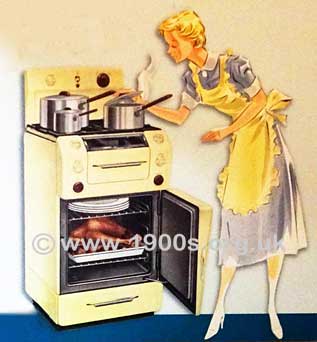Changed propaganda to suit employment needs in and after WW2


During the Second World War, there was huge propaganda to convince British women that they could readily fill men's jobs. After the war, the propaganda was diametrically and dramatically reversed in order to free the jobs for the men returned from war service. This page examines the background, shows how successful the propaganda was and highlights the difficulties that many women had in adapting to their enforced post-war role.
____
By the webmaster, based childhood observations and additional research
Why the two different propaganda
During World War Two, young fit men were conscripted to do war work, so leaving a gaping hole in the needs on the home front. Consequently women were required to step in to fill these holes. Some women were even conscripted to do so. This even continued for some years after the end of the war because demobilisation took time. Throughout this time, Government propaganda was towards women being able and happy to do men's work, however much strength and staying power was needed. There are plenty of examples throughout this website, perhaps the best one being that of land girls.
When the men returned to what was known as 'civvy street', they needed their jobs back. So began a programme of insidious propaganda in the reverse direction which I honestly hadn't seen it for what it was until I started comparing photographs from the 1940s and 1950s. Of course subtlety is always part of propaganda. That's why it works.
The new propaganda could be summarised by the idiom that seemed to be everywhere in my later childhood and teens:
'A woman's place is in the home'
Dramatically different views of the 'ideal' woman in and after WW2
Just compare the following two pictures. The first one from wartime was clearly intended to encourage women into men's work. The second from the 1950s glorifies a woman's love of cooking in her own kitchen.

Propaganda poster to encourage young women to take on men's work during World War Two

1950s advert, showing a woman with a nipped in waist and a frilly apron enthusiastically enjoying being in the kitchen
The propaganda tactics
The propaganda tactics were many, through magazines, radio programmes and posters, to name just three.
Fashion played a major part in post-war propaganda. It was towards more feminine sex appeal. Skirts became flared with nipped in waists and bras were shaped to give an upturned and pointed shape to breasts. The fashion was called the 'New Look' and my mother remarked how stupid it was to use all that extra fabric in times of such austerity. At the time, she hadn't realised it was propaganda. Neither had I, but I was only a child at the time.
The following adverts, taken from a post-war collection of newspapers illustrate the propaganda. The captions are what I believe was the hidden message, as well of course as sales.

These nipped in waists and pointed bras make the best of my figure

Cleaning my home is so satisfying

Such fun being at home with my family doing the laundry with my daughter

I must get a new carpet sweeper to keep my home clean
Note frills and bows on the women's clothes
How successful was the post-war propaganda?
The purpose at the beginning of the war was of course to fill the jobs of the men away in the military, whereas the purpose at the end of the war was to free up the jobs for the returning men. In both purposes, the propaganda was certainly successful, and the extra fabric required for flared clothes and frills was probably a small price to pay for giving the returning men their jobs back.
Some women, though, did object to their newly enforced role of losing the jobs that they had shown themselves remarkably successful in. They had become used to being valued for a job well done, bringing in their own money, being independent and having managerial responsibility. But objections achieved little or nothing. The returning men needed jobs.
The real rise in women power came in the 1960s with the contraceptive pill. By then, though, we women had to work hard to be seen in the workplace as more than individuals who just made the tea. I belonged to a women's group which aimed to counter sexism in the workplace. The fact that we had to do so shows how remarkably successful the post-war propaganda had been.
| sources | webmaster | contact |
Text and images are copyright
If you can add anything to this page or provide a photo, please contact me.



